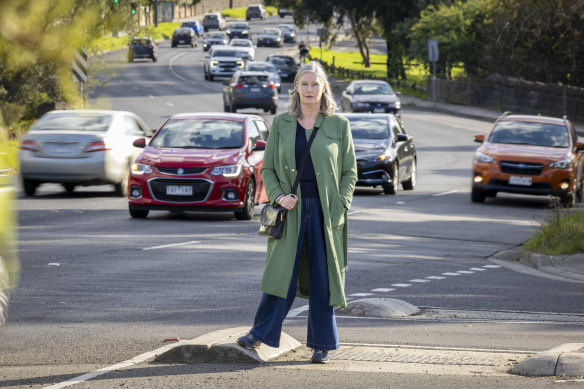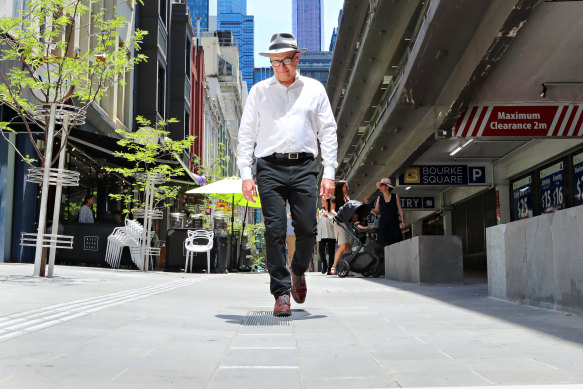This was published 1 year ago
It’s one of the most notorious roads in Melbourne. Fixing it is a ‘matter of life and death’, residents say
Victoria’s speed limits could be slashed on arterial roads and near school zones – including a notorious thoroughfare in Melbourne’s inner north – after a new report recommended an immediate review of how fast drivers are allowed to go.
The report called for measures to push drivers to stay on main roads rather than doing “suburban rat runs” through residential side streets to avoid traffic.

Coburg local Cate Hall has been lobbying to have the speed reduced at Murray Road following a spate of crashes and dangerous incidents.Credit: Wayne Taylor
The long-awaited final report of the inquiry into the impact of road safety behaviours on vulnerable road users was tabled in the Victorian parliament on Wednesday, with the committee making 56 recommendations – including a “priority” push for the state government to review speed zoning guidelines.
It called for speed limits to be reduced around school precincts and along arterial roads where there were busy activity centres.
“The inquiry found rat running was a common concern for suburban residents, who feared for the safety of vulnerable road users, including children, on these streets,” the report said.
Cate Hall, is one a group of residents, who have been lobbying for years to have the speed limit slashed at Murray Road, a notorious 60km/h thoroughfare in the inner-north suburb of Coburg.
She hoped the review of speed zones would result in Murray Road being slashed to at least 40km/h along a stretch of the road where she said cars sped precariously close to narrow footpaths, which families used to get to schools, shops and parks.
Residents say the road has turned into a “speed track” after VicRoads widened it from two lanes to four in 2011, and some drivers speed more than 80km/h, resulting in cars ploughing into front fences.
They estimate there were at least 11 crashes on the road last year alone.
“We would like to see the government now respect the good work done by the committee and urgently implement these recommendations, particularly the review of speed zones,” said Hall, who is the spokeswoman for advocacy group Safer Walking and Riding for Murray Road.
“This is a matter of life and death.”
Hall, who conducted her own research and included it in her submission to the inquiry, surveyed more than 350 members of her local community.
She found people living along the dangerous stretch of Murray Road wanted wider footpaths, separated bike paths, safer crossings and intersections, and reduced speed limits.
“Two common and strong themes were the need for speed-limit reductions and protected bike lanes,” she said.
The inquiry heard a 60km/h speed limit often applied to arterial roads, which were busy roads in urban areas, surrounded by shopping strips, tram and bus routes, with high volumes of vulnerable road users, warranting a lower speed limit.

Victoria Walks chief executive Ben RossiterCredit: Paul Rovere
Victoria Walks chief executive Ben Rossiter also welcomed the recommendations, but said the onus was now on the government to urgently act.
“This stuff, we should be doing immediately,” Rossiter said. “The key question is: How will the government respond, and will it actually follow these recommendations?”
A Victorian government spokeswoman welcomed the report and said the government would consider every recommendation made.
When reviewing speed limits, the Department of Transport and Planning takes into account factors including the surrounding road environment, crash risk and history, council recommendations, community sentiment and traffic volume.
While Rossiter backed an urgent review of speed zones, he said safer crossings on arterial roads must also be fast-tracked.
“Walkers are more likely to be killed and seriously injured when crossing major roads,” he said. “In Melbourne, just under 25 per cent of all road fatalities are walkers, so this is a really critical issue.”
The inquiry also found horse riders felt overlooked as “vulnerable road users” and “feel unsafe when motorists pass too close, at speed, or beep their horns frightening the horses”.
The push to review speed limits comes after Victoria’s key road safety agencies called for speeds to be cut to 30km/h in some busy areas in a push to save lives and prevent serious injuries.
The Victorian Government Road Safety Partners – which consists of the Transport Accident Commission, Victoria Police and the transport, justice and health departments – told the inquiry last year that setting and enforcing lower speeds was critical to making the state safer for pedestrians and cyclists.
But Victoria Police Chief Commissioner Shane Patton stoked controversy weeks later when he dismissed a plan by Yarra Council to cap speed limits at 30km/h across two inner-city suburbs in a bid to reduce serious crashes, labelling it as “ridiculous.”
Patton argued road fatalities were not happening on inner-city streets, but on rural roads, and lowering the speed limit in the City of Yarra was not the answer.
“No one’s going to obey it ... it’s ridiculous,” he said at the time.
Road safety advocates argue international research suggests if a walker is hit by a car travelling at 30km/h, they have a 90 per cent chance of survival. This plummets to just 10 per cent if a car is travelling at 50km/h.
The inquiry followed a horror period on the state’s roads when the greatest loss of life was reported in 15 years.
Last year, 296 people were killed, 24 per cent higher than in 2022, prompting calls for stronger police enforcement to correct dangerous pandemic-era driving habits, and a government commitment to review speed limits on country roads.
The inquiry found mounting anecdotal evidence suggested Victorian drivers’ behaviour had worsened during and after the pandemic, resulting in increased aggression and rule-breaking.
Among the other recommendations was a push to develop a road-user hierarchy prioritising the safety of those most at risk on the roads and the establishment of a “vulnerable road users” advisory group to contribute to the development of future road safety interventions.
The committee also recommended prioritising road treatments and speed zone reviews in regional areas and urged the government to run a targeted campaign to improve safety for vulnerable road users including walkers, people with disabilities and cyclists.
The inquiry received more than 300 submissions and held six days of hearings across the state.
Get the day’s breaking news, entertainment ideas and a long read to enjoy. Sign up to receive our Evening Edition newsletter here.